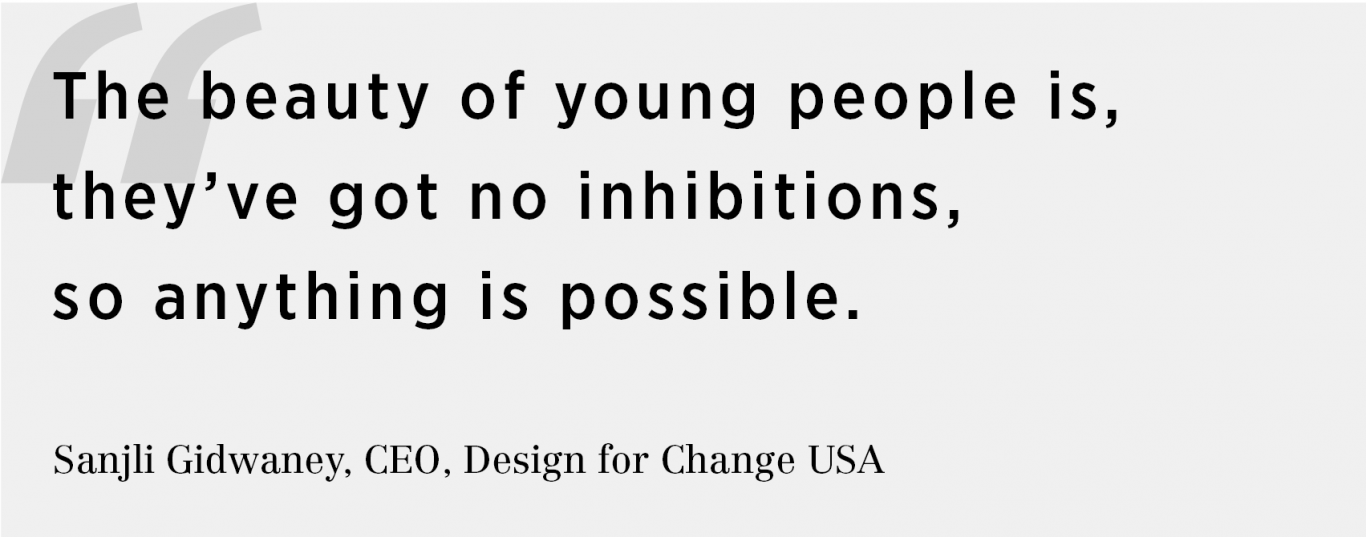
Adults don’t often feel like they have control over what happens in the world. For children, that feeling is amplified by a seemingly endless number of factors: you’re ignored (even when you scream at the top of your lungs); you know there is more to a situation, but for some reason, you can’t get the whole story; everything around you is bigger than you. There are also many adults in the world, as Sanjli Gidwaney pointed out at her recent Design Museum Morning presentation, who can make children feel like they have no agency, as if they actually are powerless, and their voice has no weight because they are young. Gidwaney, who is the CEO of Design for Change USA, stated that skepticism, naysaying and condescension from adults affects children’s lives every day.
Children want to improve their own communities just as much as anyone else. And, when provided the proper tools and encouragement, they can sometimes have a bigger impact than an adult. Design for Change, an international non-profit organization originally founded in India, operates on the premise that the secret ingredient that can turn children’s problem-solving ideas into reality is design thinking.
Design thinking, by definition, puts users at the center of the problem-solving process by working with them, instead of for them, to develop solutions. By teaching children this approach to solving problems in their communities, it sets them up to think more effectively about how to solve the issues they’re interested in for the rest of their lives.
Using a design-based model to approach problem-solving, Design for Change offers students ages 5-17 the opportunity to pursue their ideas for tackling singular problems in their communities as a group, guided by a few adult mentors, but largely investigating, brainstorming and implementing solutions themselves. This model, which is the foundation of Design for Change’s method, is a simple four-step process that can be completed in a few hours or a few months:
Feel: Young people observe and list the issues in their community that bother them.
Imagine: They interact with folks in their community to identify points of intervention and solutions.
Do: They develop and implement an action plan, keeping in mind resources, budget and time.
Share: They share their story of change and inspire others to get involved or do their own project.
And what kinds of community issues are children across America tackling with Design for Change? Gidwaney shared the story of middle schoolers in Sandpoint, Idaho, who worked with student counselors and first responders to reduce suicide rates among young people. She also mentioned students in Raleigh, North Carolina, who focused on five major issues in their city, including food deserts and local water pollution.
At the end of her presentation, Gidwaney reminded us that despite the everyday naysayers, children are naturally resilient; instead of trying to control or limit that resiliency, Design for Change gives them an opportunity to practice it. That opportunity is branded as a great equalizer for children: no matter where they come from or what their resources are, all children have the capability to practice design thinking and carry that mindset with them throughout their lives.

Working in a high-energy, constantly moving environment like PAYETTE, I’m always surrounded by impassioned conversations among designers and design thinkers. At Design Museum Mornings, it was refreshing to be reminded that the joy of digging deep into the many dimensions, perspectives and paths a challenge encompasses can be found by anyone, anywhere, regardless of their location, education level or age.
Related links:
Architecture Design and Thinking Day
Design Museum Mornings: Design for Age
Design Thinking with IBM


